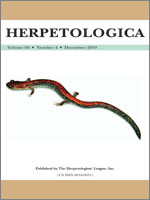We used radiotelemetry to study the movements and habitat use in a population of Nerodia fasciata fasciata in the upper coastal plain of South Carolina from 2002 to 2006. Snakes that were surgically implanted with radiotransmitters were tracked during late spring of each year and located most days until the onset of hibernation in mid-November. Data were divided into summer and fall for seasonal analysis. Most home-range estimates and associated measures were significantly smaller during fall. Banded watersnakes used shoreline and littoral zone habitats in excess of their availability and used open water and terrestrial habitats relatively infrequently. Shoreline habitats were used more often during the fall, whereas littoral zone habitats were used more in the summer. Movement frequency was high relative to what has been reported for other Nerodia species. Females used shoreline habitats more than males, whereas males used littoral zone habitats more frequently.
How to translate text using browser tools
1 December 2010
Seasonal Variation in the Spatial Ecology of the Banded Watersnake (Nerodia fasciata fasciata)
Jeffrey D. Camper,
Lacy D. Chick
ACCESS THE FULL ARTICLE

Herpetologica
Vol. 66 • No. 4
December 2010
Vol. 66 • No. 4
December 2010
habitat use
home range
movements
Nerodia fasciata
seasonal variation
spatial ecology




